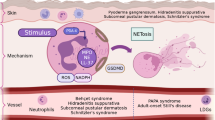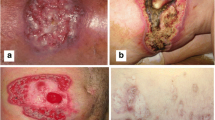Abstract
Molluscum contagiosum, a condition characterized by benign viral tumours, occasionally becomes inflamed and regresses spontaneously, an event probably initiated by a host cell-mediated immune rejection against the lesion, but it inevitably involves the disruption of the epidermal tissue to expose the molluscum bodies to the tissue fluids of the dermis. It has been suggested that the molluscum bodies induce inflammation by a mechanism similar to that involved in ruptured epidermal cysts or in acne. Despite the occasional development of inflammation in molluscum contagiosum, the proinflammatory properties of molluscum bodies have never been studied in vitro. Thus, in the present study we sought to determine whether molluscum bodies exert a proinflammatory effect by inducing neutrophil chemotaxis. When exposed to fresh serum in vitro, water-insoluble components of molluscum bodies activated the alternative complement pathway to produce chemotactic C5a/C5a des Arg. We also found that an aqueous extract of molluscum bodies exerted potent chemotactic activity for neutrophils. Remarkably high amounts of the immunoreactive proinflammatory cytokines IL-8 and GROα were present in the extract even when compared with psoriatic scale extracts. Gel filtration HPLC of the extract demonstrated the presence of neutrophil chemotactic activity over a wide range of molecular mass. These data suggest that disruption of the epidermal wall of molluscum bodies induces acute inflammatory changes by activation of the alternative complement pathway on exposure to the tissue fluids, and that the molluscum bodies themselves release proinflammatory cytokines and other neutrophil chemotactic factors on decomposition.
Similar content being viewed by others
References
Berman A, Winkelmann RK (1980) Involuting common warts: clinical and histopathologic findings. J Am Acad Dermatol 3: 356–362
Brandrup F, Asschenfeldt P (1989) Molluscum contagiosum-induced comedo and secondary abscess formation. Pediat Dermatol 6: 118–121
Cotton DWK, Cooper C, Barrett DF, Leppard BJ (1987) Severe atypical molluscum contagiosum infection in an immunocompromised host. Br J Dermatol 116: 871–876
DeOreo GA, Johnson HH Jr, Binkley GW (1956) An exzematous reaction associated with molluscum contagiosum. Arch Dermatol 74: 344–348
Epstein WL, Senecal I, Kransnobrod H, Massing AM (1963) Viral antigens in human epidermal tumors: localization of an antigen to molluscum contagiosum. J Invest Dermatol 40: 51–59
Goldschmidt H, Kligman AM (1958) Experimental inoculation of humans with ectodermotropic viruses. J Invest Dermatol 31: 175–182
Henao M, Freeman RG (1964) Inflammatory molluscum contagiosum: clinicopathological study of seven cases. Arch Dermatol 90: 479–482
Katzman M, Carey JT, Elmets CA, Jacobs GH, Lederman MM (1987) Molluscum contagiosum and the acquired immunodeficiency syndrome: clinical and immunological details of two cases. Br J Dermatol 116: 131–138
Kipping HF (1971) Molluscum dermatitis. Arch Dermatol 103: 106–107
Lazarus GS, Tost FJ, Thomas CA (1977) Polymorphonuclear leukocytes: possible mechanism of accumulation in psoriasis. Science 198: 1162–1163
Levin J, Tomasulo PA, Oser RS (1970) Detection of endotoxin in human blood and demonstration of an inhibitor. J Lab Clin Med 75: 903–911
Lutzner MA (1963) Molluscum contagiosum, verruca and zoster viruses. Arch Dermatol 87: 436–444
Mehregan AH (1961) Molluscum contagiosum: a clinicopathologic study. Arch Dermatol 84: 123–127
Pierard-Franchimont C, Legrain A, Pierard GE (1983) Growth and regression of molluscum contagiosum. J Am Acad Dermatol 9: 669–672
Pinkus H, Frisch D (1949) Inflammatory reactions to molluscum contagiosum, possibly of immunologic nature. J Invest Dermatol 13: 289–294
Reed RJ, Parkinson RP (1977) The histogenesis of molluscum contagiosum. Am J Surg Pathol 1: 161–166
Schroder J-M (1992) Generation of NAP-1 and related peptides in psoriasis and other inflammatory skin disease. In: Baggiolini M, Sorg C (eds) Interleukin-8 (NAP-1) and related chemotactic cytokines. (Cytokines, vol 4). Karger, Basel, pp 54–76
Shelley WB, Burmeister V (1986) Demonstration of a unique viral structure: the molluscum viral colony sac. Br J Dermatol 115: 557–562
Shirodaria PV, Matthews RS, Samuel M (1979) Virus-specific and anticellular antibodies in molluscum contagiosum. Br J Dermatol 101: 133–140
Steffen C, Markman J-AK (1980) Spontaneous disappearance of molluscum contagiosum. Arch Dermatol 116: 923–924
Tagami H, Ofuji S (1977) Characterization of a leukotactic factor derived from psoriatic scale. Br J Dermatol 97: 509–518
Tagami H, Takigawa M, Ogino A, Imamura S, Ofuji S (1977) Spontaneous regression of plane warts after inflammation. Arch Dermatol 113: 1209–1213
Takematsu H, Tagami H (1993) Quantification of chemotactic peptides (C5a anaphylatoxin and IL-8) in psoriatic lesional skin. Arch Dermatol 129: 74–80
Takematsu H, Terui T, Torinuki W, Tagami H (1987) Leukocyte chemotactic properties of soluble horny contents in epidermal cysts. Arch Dermatol Res 279: 449–453
Takematsu H, Isono N, Kato T, Tagami H (1990) Normal human epidermal keratinocyte-derived neutrophil chemotactic factor. Tohoku J Exp Med 162: 1–13
Terui T, Rokugo M, Kato T, Tagami H (1989) Analysis of the proinflammatory property of epidermal cyst contents: chemotactic C5a anaphylatoxin generation. Arch Dermatol Res 281: 31–34
Terui T, Kato T, Tagami H (1989) Stratum corneum activation of complement through the antibody-independent alternative pathway. J Invest Dermatol 92: 593–597
Author information
Authors and Affiliations
Rights and permissions
About this article
Cite this article
Takematsu, H., Tagami, H. Proinflammatory properties of molluscum bodies. Arch Dermatol Res 287, 102–106 (1994). https://doi.org/10.1007/BF00370727
Received:
Issue Date:
DOI: https://doi.org/10.1007/BF00370727




